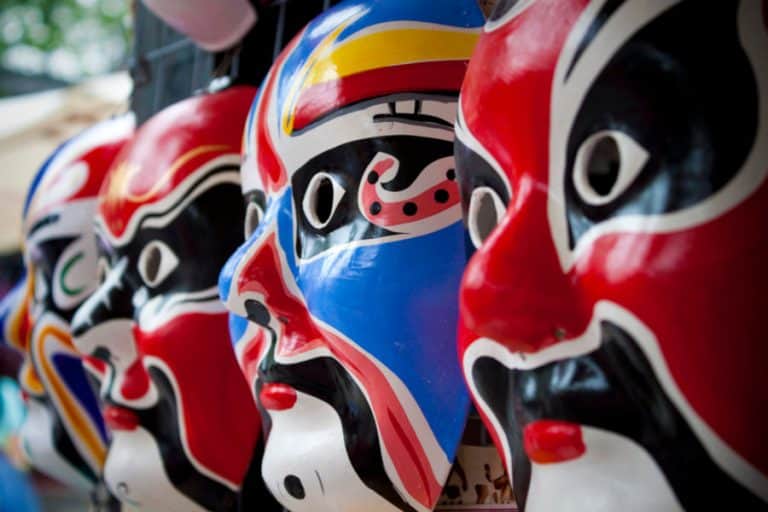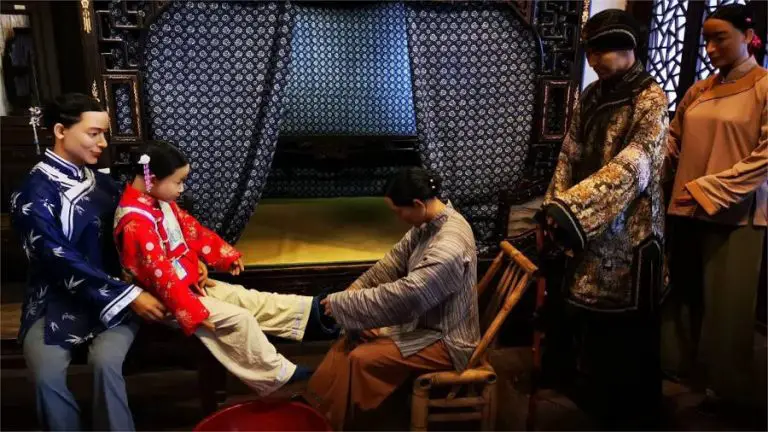Although many in the West will be more familiar with operas by Italian or German composers, Chinese opera is an art with a long and fascinating tradition which is well worth learning more about. In this article, we explore the specificities of Chinese opera, its rich history and everything you need to know about the symbolism involved in this intriguing art form.
The History of Chinese Opera
The history of Chinese Opera is as complex as its tradition. To understand it is also to understand something of Chine art history and of the history of the country as a whole. Here, we have compiled an express history of this long-standing art form.
The beginnings of Chinese Opera go back hundreds of years, to the Qin Dynasty, who saw the first-ever Chinese Opera troupe touring the country. Although back then, the art was not nearly as evolved as it is today, there were already a couple of recognizable traditions. For example, from its beginnings, Chinese opera used tropes, archetypal characters that came back in every single production. Those included the man, the woman, the clown, and the mysterious painted face, or ‘hua’. Those characters, as well as the costumes that went with them, are still a staple of Chinese operas today.
It was Emperor Xuanzong who created the first official national cinema troupe, the ‘Pear Garden’ in the early 700s. This started a long history of friendship between Chinese leadership, and this beloved art form. Only during the Communist period did the relationship between State and Opera shift considerably.
It was over a millennium after the birth of the first Chinese opera that it became accessible to the masses. Indeed, only in the 13th century did the use of vernacular Mandarin become popularized as opera languages, taking over the more learned form of Classical Chinese.
This made Chinese Opera a truly ‘popular’ form, able to speak to people who may have been uneducated and to those who spoke other local languages. For example, Cantonese opera is one of the main branches of traditional Chinese Opera, with troupes performing in Cantonese rather than Mandarin.
Although the Communist era marked a dreadful shift for Chinese Opera, at its beginnings, the newly formed communist regime encouraged folk forms of Chinese opera. One can even argue that this art form was renewed and had some of its greatest successes during this historical era. As the political climate became a lot more hostile toward any artists accused of subversion however, Chinese Opera began to suffer.
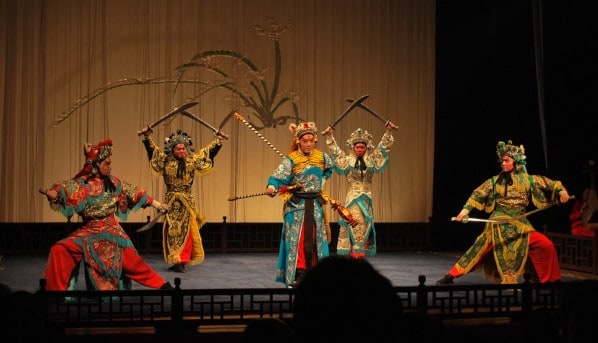
The Cultural Revolution, which lasted from 1966 to 1976 left its blood mark on Chinese Opera. During that time, the communist regime in place attempted to destroy any remnants of Chinese tradition in the country, from dress and superstitions to arts and literature.
Hundreds of composers, scriptwriters and performers were purged during that era and performances of Chinese operas came to a halt. Only eight operas were allowed to be played during the whole of that decade, essentially stifling the creativity and inventiveness of Chinese opera performers all over the country.
When the bloodiest days of the Cultural Revolution were over, Chinese Opera slowly started picking up again. Old masters were once more able to transmit their trade to young artists and performances became legal once more.
In modern-day China, one cannot say that Chinese Opera is completely free. For example, many operas are still banned and many new ones are stopped from even seeing the light of day by government censorship. Rich from its age-old heritage, however, Chinese Opera remains a powerful force in the contemporary Chinese performance art world. Chinese opera lovers today are encouraged to admire the latest productions at the Peking opera of Beijing, the National Cantonese opera or the Huju opera of Shanghai.
| Period | Event or Milestone | Significance |
|---|---|---|
| Qin Dynasty (221–206 BCE) | Early performance troupes formed | Beginnings of Chinese theatrical tradition |
| Tang Dynasty (618–907) | “Pear Garden” established by Emperor Xuanzong | First official state-supported opera troupe |
| Yuan Dynasty (1271–1368) | Use of vernacular in opera script | Made opera accessible to the general populace |
| Qing Dynasty (1644–1912) | Rise of Peking Opera | Codification of modern opera forms |
| Cultural Revolution (1966–1976) | Opera heavily censored, artists persecuted | Major interruption in opera tradition |
| Post-1980s | Opera revival and modernization | Global interest and innovation |
Check out our “Free Culture Library“. We have compiled some great free resources, about Chinese culture, for your research.
Regional Variants of Chinese Opera
While Peking Opera (Jingju) is the most internationally recognized form, China’s vast geography and linguistic diversity have given rise to over 360 regional opera styles, each with its own distinctive music, vocal styles, and staging conventions. Understanding these styles reveals how opera was shaped by local culture and dialects.
- Kunqu Opera: One of the oldest forms, dating back to the 14th century, Kunqu is known for its poetic elegance, refined gestures, and sophisticated librettos. It was favored by the elite during the Ming and Qing dynasties and is considered the “mother” of many later opera forms. In 2001, it was declared a Masterpiece of the Oral and Intangible Heritage of Humanity by UNESCO.
- Yue Opera (Shaoxing Opera): Originating from Zhejiang province, this style is unique for its all-female casts, which emerged during the early 20th century. Yue Opera emphasizes romance and melodrama and is characterized by graceful movements and lyrical singing. It remains extremely popular in southern China.
- Qinqiang Opera: From Shaanxi province, Qinqiang features powerful vocal projection and bold, masculine roles. It often focuses on historical narratives and folk tales and retains more rustic elements than more polished southern styles.
- Hunan’s Huaguxi and Sichuan Opera are also notable. The latter is famous for its “face-changing” (变脸, biàn liǎn) technique, where actors change masks in a split second to convey sudden shifts in mood or identity — a spellbinding spectacle for modern audiences.
| Opera Type | Origin Region | Language Used | Key Characteristics | Notable Features |
| Peking Opera | Beijing | Mandarin | Stylized, elaborate costumes, martial elements | National symbol, most well-known globally |
| Kunqu Opera | Jiangsu/Zhejiang | Classical Chinese | Elegant, poetic, fluid movement | UNESCO heritage, refined performance style |
| Yue Opera | Zhejiang | Wu dialect | Melodic, female-led performances | All-female casts, romantic themes |
| Sichuan Opera | Sichuan | Southwestern Mandarin | Bold, fast-paced, face-changing stunts | “Bian Lian” (face changing) |
| Qinqiang Opera | Shaanxi | Northwestern dialect | Guttural singing, rural themes | Oldest surviving form, high-pitched vocals |
Chinese Opera Characters
As discussed earlier, the 4 main roles of Chinese Opera: male, female, painted face, and clown, have been an important part of this art form from the onset. The roles themselves, however, are just general categories and are further subdivided. Here is some context on the four major roles of Chinese Opera:
Sheng, or the male role.
Male characters in Chinese Opera generally belong to one of three categories: the young man, the old man, and the acrobatic figure.
- Young men can be romantic leads, children, or even the hero of the story. The actors who play them must possess an extraordinarily high-pitched voice, and this is a highly technical singing role.
- Old men, on the other hand, are often archetypal figures of the wise old man, the guide, or the villain.
- Finally, the acrobatic male role is usually a military role, given to a man capable of accomplishing feats of acrobatics while on stage. They will usually perform in stylized ritual combats, or be shown fighting against gods and demons. This is a technical role as much as the other ones, which requires particular strength and ability.
Dan, or the female role
The female characters of Chinese Opera come in a great number of variations. They may be virtuous (Qing Yi), seductive (Hua Dan), young mothers (Gui Men Dan), women generals (Dao Ma Dan), acrobats (Wu Dan) or older women (Lao Dan).
The abilities required by the actresses depend largely on the role that they are assigned. The Qing Yi role is all about grace and elegant dancing, the voice of the actress must be high and sincere.
The Hua Dan character is a much more comic and dramatic look, for which the actress must play at once a flirtatious woman, and be able to generate laughter from the audience. Her voice must be strong, although she won’t have to sing much. For the Wu Dan role of the acrobat, great strength and skill is required of the actress.
All six roles come with their own costumes, which makes it easy for spectators to understand the archetypes which they are facing in any Chinese Opera.
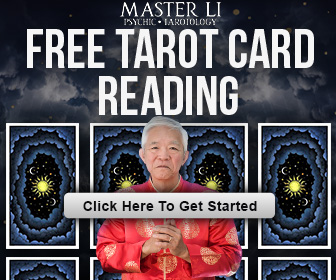
The Jing, or ‘Painted Face’ Role
There is no mistaking the Jing role for any other. The actor playing that part will be wearing bright, dramatic costumes, expressive facial makeup, and sometimes even a mask.
As to the role that they play, the Jin is generally a courageous and strong army general or warrior. The role has less emphasis on dancing and singing. Rather, the character is depicted as strong, able, and unsophisticated.
The Chou, or Clown Role
The Chou is the clown of the troupe. The purpose of this character is to generate laughter through amusing gestures and slapstick humor. As a general rule, the Clown role is attributed to a character who is dimwitted, and mischievous in his actions.
Clowns are neither good nor bad, they are the source of much of the comedy of Chinese Opera, and are neither particularly virtuous nor villainous.
| Role Type | Subtypes | Key Traits | Vocal/Movement Style |
| Sheng (Male) | Lao Sheng (old man), Xiao Sheng (young man), Wu Sheng (military) | Noble, heroic, or romantic | Singing-focused, some acrobatics |
| Dan (Female) | Qing Yi (virtuous), Hua Dan (flirtatious), Wu Dan (acrobat), Lao Dan (elderly) | Graceful, emotive, or comedic | Singing and stylized dance |
| Jing (Painted Face) | None (categorized by color) | Forceful, dramatic, warriors or rebels | Loud, powerful delivery |
| Chou (Clown) | Wen Chou (civil), Wu Chou (military) | Comedic, cunning, disruptive | Spoken lines, slapstick movements |
Check out our “Free Culture Library“. We have compiled some great free resources, about Chinese culture, for your research.
The Musical Structure of Chinese Opera
An often overlooked aspect of Chinese Opera is its musical structure, which is central to the storytelling experience. The music blends percussive, string, and wind instruments in ways that highlight character emotion, rhythm, and action.
- The jinghu, a high-pitched, two-stringed fiddle, leads the melody in Peking Opera. Its shrill timbre mirrors the heightened emotion of the performance.
- Percussion, especially the bangu (flat drum) and gongs, cue transitions, fight scenes, and moments of dramatic tension.
- Each character role type (sheng, dan, jing, chou) has its own melodic mode and rhythm patterns, contributing to the psychological cues that guide the audience.
Additionally, Chinese opera uses recitative-like speech-singing, known as “nian bai”, in combination with sung arias. The balance of spoken and sung lines reflects the emotional tempo of a scene.
Chinese Opera Costumes
Chinese Opera costumes are very diverse and creative but are also strictly codified.
- The first function of a costume in Chinese Opera is to convey the role or archetype of the character on the stage.
- The second function of the costume is to impress, as they are often beautifully designed and adorned pieces of clothing.
Here are a few of the costumes you may find on a Chinese Opera stage:
Watch out for characters in black hats and military uniforms, those are most often Lao Sheng, or young man.
Even easier to spot is the costume of the Hua Dan, the seductive woman. A Hua Dan is generally wearing very brightly colored clothes and is seen carrying a handkerchief in her hand. In fact, the handkerchief will play a big role in her seductiveness. Generally, she is associated with the colors red and pink, which symbolize passion and sexuality.
The female warrior or Dao Ma Dan has a characteristic costume comprising a Kao which is attached to her back and ornate but practical clothes. The costume of the Dao Ma Dan is all about impressing. It impresses because it conveys an impression of force on the one hand, but also because it is beautifully and richly adorned.
The easiest costume to spot in Chinese Opera is that of the Jing, which is heavy, dramatic, and impressive. The costume is generally padded on all sides to give the impression of a particularly robust character, while the heavy headdress adds to the height.
Chinese Opera costumes are an art form in and of themselves. The skill that goes into making them is as developed and ancient as the opera form. The best Chinese Operas know how to use costumes not only to signify the roles of each of the actors on the stage but also to add to the magic of the spectacle.
| Character Type | Costume Elements | Symbolism/Function |
| Sheng (young) | Long robes, black hat, subtle colors | Modesty, authority |
| Dan (Qing Yi) | Embroidered dresses, long sleeves | Grace, refinement |
| Hua Dan | Bright, flirtatious dress, handkerchief | Seduction, vitality |
| Jing | Armored robes, high headdress, bold padding | Power, fearlessness |
| Chou | Simple costume, white nose paint | Humor, humility |
Chinese Opera Masks
Chinese Opera Masks are one of the main differences between Western opera and Chinese Opera. At first glance, Chinese Operas impress with their use of colors and imaginative costumes. The characters don’t only play a role, their whole outfit and appearance reveals and embodies the role which they are assigned.
Chinese Opera masks have a strong symbolic function, as they allow the spectator to see which character is to be trusted, which is the hero, which will be the villain etc. Furthermore, those masks serve an aesthetic function.
Chinese Opera is above all colorful, in its masks as well as costumes, decorations and the vividness of the actions that are staged. The colorful masks add to the drama of the play and make Chinese Opera the beautiful feat of multi-dimensional performance art that it is.
Take a look at these awesome Opera Masks.– Aff.link
The History of Chinese Opera Masks
Long before colorful masks were used in Chinese Opera, they served a totemic function in Chinese society.
Even before the advanced of the opera, masks were used for their symbolic functions. In tales, stories, and paintings, masks were used to signify the character of a figure, whether it be malevolent, cunning, or courageous.
When Chine Opera developed, the troupes naturally turned to these age-old traditions and used well-known mask codes that spectators could readily understand because they were already present in the culture.
The Symbolism of Chinese Opera Masks Colors
Nothing is left to chance in Chinese Opera, and even the masks have a strong color symbolic associated with them. To understand the action, but also the relationships between characters in Chinese Opera, you need to be able to understand the meaning of mask colors.
One of the most common masks is makeup in the center of the face, in between the eyes and the nose. The character who wears that mask is simply ‘hua’, the clown. This character is present in most Chinese Operas and is an age-old archetype who provides comic relief throughout the play.
- Red is a very positive color in Chinese art and used on a mask it denotes bravery, fairness, and loyalty. In general, characters with mainly red masks can be trusted and are the heroes of the story.
- Black is equally positive, with connotations linked to decisiveness and impartiality.
- Pink masks are a sign of elegance, high standards, and gentlemanly behavior.
- Blue symbolizes courage but can also mean that the character has some psychic abilities. In a Chinese opera play, always trust the predictions of the blue-masked character!
- Green is not as positive, connoting erratic and unpredictable behavior.
- Yellow is a more devious color still, although it is not always negative. Characters who wear yellow masks are ambitious, sometimes to a fault.
- Finally, characters who wear white masks are mean, cruel and manipulative. You will be able to recognize them as anti-heroes straight away.
Take a look at these awesome Opera Masks.– Aff.link
Stagecraft and Gesture: The Language of Movement
Chinese Opera stages are often minimal, but every movement on them is filled with meaning. Audiences are expected to understand a highly codified system of gestures and postures, which convey time, setting, and mood.
- A performer miming riding a horse, simply by walking in circles while holding reins, immediately signals a journey or battle scene.
- Eye movement and sleeve choreography are crucial, particularly for dan (female) roles. A single flick of a long “water sleeve” can indicate sorrow, shyness, or rage.
- Symbolic props (like a fan or a whip) represent objects or settings. For example, a painted square rug may stand for a palace or a mountain depending on the scene.
This abstract style of staging allows for a theatrical suspension of realism, focusing instead on poetic expression and aesthetic beauty.
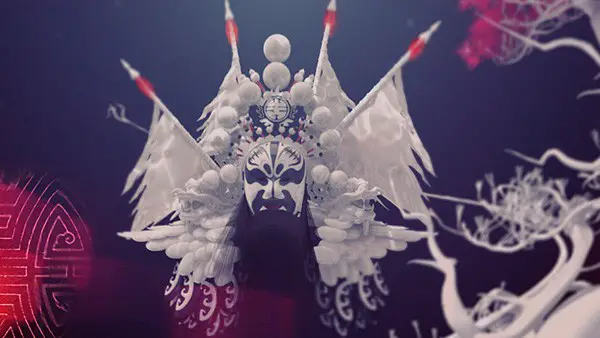
A Few Facts About Chinese Opera
- When we talk about ‘Chinese Opera’, what we are really talking about is the sum of over 360 different types of opera, including but not limited to Peking Opera and Cantonese Opera.
- Some types of Chinese Opera include circus techniques such as fire breathing and extreme acrobatics as part of their narrative.
- The Makeup and Costumes of Chinese Opera actors can take literal hours to put on. Preparation for the play far exceeds the length of the play itself.
- Costumes for Chinese Opera are so intricate and beautiful that they are kept over generations. It is not rare for an actor to wear the costume that his mentor wore before him.
- In China, it is not rare for men to play female characters in Chinese Operas. This is not considered unusual and is readily accepted by spectators as just a quirk of the play.
The Revival and Modern Influence of Chinese Opera
Today, Chinese opera is experiencing a revival among younger audiences thanks to innovations in staging and multimedia. Directors are blending traditional techniques with contemporary technology, such as:
- Projection mapping, digital backdrops, and lighting effects to replace or enhance minimal sets.
- Collaborations between Chinese Opera troupes and modern theater companies, both domestic and international.
- A growing presence in film, fashion, and pop culture, with opera elements seen in movies by directors like Zhang Yimou or in high-fashion runways.
Schools and cultural institutions across China are also investing in youth opera programs, aiming to preserve this heritage while adapting it to modern tastes.
Stay in Touch
 Join our newsletter by using the forms on this website or click here!
Join our newsletter by using the forms on this website or click here! Follow us on Google News
Follow us on Google News Follow us on Facebook
Follow us on Facebook
Images:
- Feature Image from Depositphotos
- “Warriors” by -LJ- is licensed under CC BY-NC-ND 2.0
- “SHIFT” by Jimmy Yuan is licensed under CC BY-NC-ND 4.0





